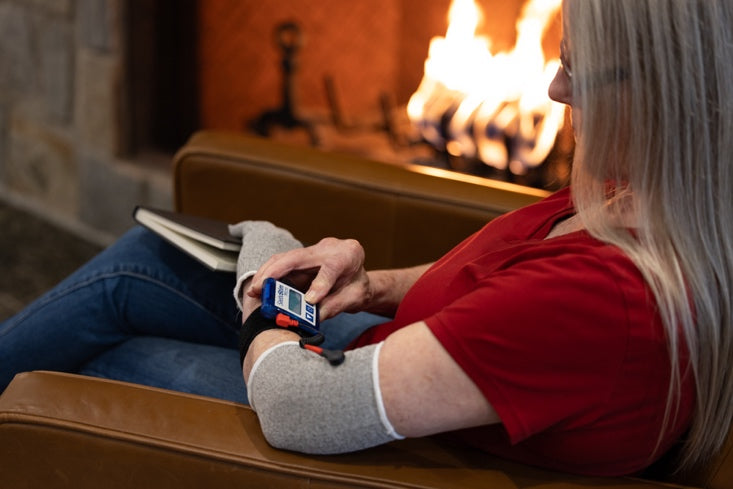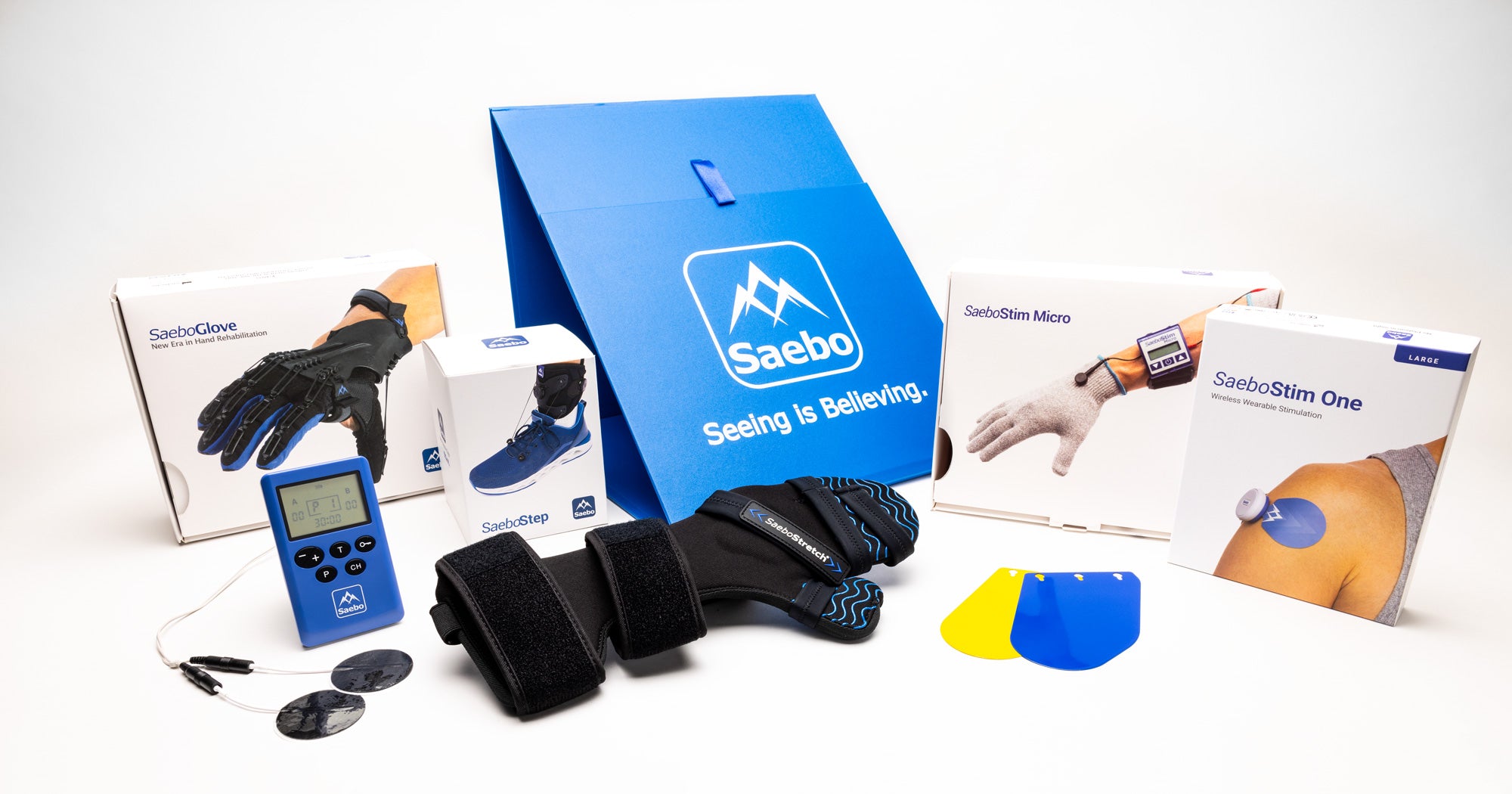Electrical Stimulation for Stroke Rehab: How NMES, SES, and TENS Boost Recovery

This blog will provide a framework for how electrical stimulation (E-stim) supports stroke recovery and help you identify the different types of stroke rehab technology, including NMES, SES, and TENS. We'll look at some of Saebo's specialized stroke rehab devices and their unique capabilities and uses. You'll discover the best practices with E-stim and how E-stim blends with other treatments to maximize recovery outcomes.
E-stim therapy is transforming stroke recovery. By harnessing targeted currents, this proven approach helps rebuild motor function, prevent muscle atrophy, and accelerate rehabilitation. Yet many therapists, patients and caregivers alike remain unaware of the different types available. From Neuromuscular Electrical Stimulation (NMES) to Transcutaneous Electrical Nerve Stimulation (TENS) and Sensory Electrical Stimulation (SES), each technique plays a unique and vital role in restoring movement and independence.
Understanding Electrical Stimulation in Stroke Rehab
What is electrical stimulation therapy?
Electrical stimulation therapy delivers controlled currents to nerves and muscles through non-invasive electrodes placed on the skin. These electrodes send mild electrical impulses that make muscles contract or stimulate nerves, like your brain's natural electrical signals. This powerful tool helps stroke patients recover by targeting damaged motor neural circuits [1].
Different types of electrical stimulation serve unique therapeutic purposes:
- Neuromuscular Electrical Stimulation (NMES) uses short electrical pulses to excite peripheral nerves and create muscle contractions through surface electrodes
- Functional Electrical Stimulation (FES) works by coordinating multiple muscle contractions that produce functional movements
- Transcutaneous Electrical Nerve Stimulation (TENS) helps manage pain while helping restore sensorimotor function
- Sensory Electrical Stimulation (SES) enhances sensory feedback without necessarily causing muscle contractions
How stroke affects muscle and nerve function
A stroke damages parts of the brain so that it can no longer effectively send chemical and electrical signals needed for muscle movement. Researchers have found that motor units in affected muscle tissue decrease within just 4 hours after a stroke begins [2]. The muscles themselves aren't damaged - the neural pathways between brain and muscles stop working properly.
Muscle function changes continue over time. Muscle loss and atrophy start developing by day 10 after the stroke, especially when patients are older. After a stroke, the way the brain and nervous system send signals to the muscles can change. Because of this, the affected muscles (paretic muscles) don’t always receive clear or strong signals, which makes it harder for them to produce normal force and movement.
The Role of Neuroplasticity in Recovery
Your brain's amazing ability to reorganize itself by forming new neural connections - neuroplasticity - is crucial for stroke recovery. Electrical stimulation helps speed up this process in stroke patients by enabling new connections while bypassing damaged tissue.
The stimulation releases neurotransmitters that help create new neural pathways. These therapies continue to affect neural synaptic plasticity even after the treatment ends. Regular use strengthens the connections between brain and muscles, which rewires the damaged brain and improves function.
Studies show that combining stimulation therapy with targeted exercises helps neuroplasticity work better than using either method alone. This makes it an important part of complete stroke rehabilitation programs [3]. Essentially, neuroplasticity exercises are targeted activities that stimulate the brain’s ability to rewire itself, strengthening new neural connections to restore lost skills and improve function after injury or illness.
Types of Electrical Stimulation: NMES, FES, SES, and TENS
Electrical stimulation therapy exists in several forms that serve different therapeutic purposes in stroke rehabilitation. Learning about these variations helps you select the right approach that matches specific recovery needs.
Neuromuscular Electrical Stimulation (NMES) and Functional Electrical Stimulation (FES)
Neuromuscular stimulation sends short pulses through surface electrodes to stimulate nerves and create muscle contractions. The stimulation settings can be adjusted and determine how strong the contractions are and how long the muscles can work before getting tired. In general, higher settings can produce stronger contractions, but they may also cause muscles to fatigue more quickly. NMES for stroke patients is essential as it helps muscle re-activate and restores motor function.
FES works as a specialized form of NMES. The main difference lies in patient participation. Traditional NMES follows preprogrammed patterns passively, while FES combines with voluntary contractions during functional tasks like walking, standing from chairs, or grasping objects. This blend of stimulation with purposeful activities makes FES valuable to relearn motor skills.
Sensory Electrical Stimulation (SES)
SES differs from motor-focused stimulation. It operates at intensities near the sensory threshold without causing major muscle contractions. This gentle stimulation targets sensory nerve fibers instead of motor pathways.
Sensory Electrical Stimulation (SES) works by sending gentle electrical signals through the skin, which encourages the brain to adapt and rewire itself. This type of stimulation can improve movement, reduce muscle tightness (spasticity), and help restore more normal sensation — even if it doesn’t cause the muscles to visibly move.
Transcutaneous Electrical Nerve Stimulation (TENS)
TENS for stroke recovery helps manage pain by sending gentle electrical signals that block pain messages from reaching the brain. For people recovering from a stroke, TENS can do more than reduce discomfort—it can also support overall movement and rehabilitation [4]. Research shows that when TENS is used alongside regular training exercises, it can improve voluntary movement and functional recovery better than training alone. Using it on both sides of the body may provide even greater benefits.
When to use each type of E-stim
Your rehabilitation goals determine the choice of stimulation type:
- Choose NMES to strengthen muscles, reduce spasticity, and increase range of motion when active movement remains limited.
- FES works best to recover functional movement and task-specific training, especially for activities like grasping objects or walking.
- SES helps improve sensory awareness, reduce neglect, decrease spasticity, and “primes” the motor cortex to make training more effective
- TENS works best to manage pain or support movement therapy at the time when pain limits participation.
Early in stroke recovery (subacute stage), NMES and FES are most effective for strengthening muscles and retraining movement but can continue to be effective throughout recovery. SES and TENS can be used anytime to improve sensory awareness or manage pain and support therapy.
Applications of Electrical Stimulation
Let's explore specific electrical stimulation devices designed for stroke rehabilitation and their ground applications, as well as stroke rehabilitation exercises that support neuroplasticity.
SaeboStim One: Wearable NMES Device
The SaeboStim One delivers targeted wireless stimulation to treat common post-stroke complications. The One is a small, wearable device intended for intuitive at-home use. Due to the sleek and simple design and the absence of lead wires, this is an effective tool for multiple treatment situations such as:
- Reducing shoulder subluxation – Strengthening shoulder muscles (particularly the deltoid) to help keep the joint properly aligned after neurological injury.
- Improving hand and arm function after stroke – Helps stimulate weak muscles to improve motor control and strength.
- Preventing or treating foot drop – Activates the ankle dorsiflexors to aid in safer walking.
SaeboStim Pro: All-in-One Stimulation Device
The SaeboStim Pro stands out from single-function devices by combining multiple stimulation types in one pocket-sized portable, dual-channel unit. The device delivers NMES to activate muscles, TENS to manage pain, and has the option for SES with the addition of the available sensory glove portion. A unique trigger button lets patients time their muscle activation precisely while they practice daily activities, like an FES device. By timing muscle activation with specific functional tasks—like reaching for a cup, grasping an object, or lifting the foot during walking—the device encourages task-specific practice. This kind of practice is highly effective for motor learning because it reinforces the exact movement patterns the patient wants to improve.
SaeboStim Micro: Sensory stimulation for hand and arm
The SaeboStim Micro uses a different strategy with low-level sensory electrical stimulation (SES) that doesn't cause muscle contractions. The device comes with three essential parts: Electro-Mesh conductive garments (glove and arm sleeve), a compact stimulator with LCD display, and connecting lead wires. It boosts signals to the brain, which helps recovery for patients with spasticity, pain, edema or limited awareness in the affected limb. This device has two setting allowing for targeted, shorter session during specific exercise or a longer, 8-hour treatment option ideal to wear overnight.
How to choose the best NMES device for your needs
Your rehabilitation goals should guide your choice of therapeutic stimulation device:
- TENS is most suitable if your main goal is pain relief.
- NMES is ideal for muscle strengthening and supporting motor recovery.
- SES can help improve sensory awareness, reduce neglect, and prepare the nervous system for functional training.
- Dual-function devices offer more flexibility by combining pain relief and muscle activation in one device.
It’s also important to consider the device’s overall features, ease of use, and customization options to suit your therapy needs.
Combining E-Stim with Other Therapies for Better Results
Research shows that E-stim produces the best results when combined with other rehabilitation methods [5]. Using it alongside conventional therapies—such as task-specific exercises, strength training, or functional practice—enhances muscle activation, reinforces proper movement patterns, and accelerates overall recovery. This combined approach leverages both the neural and muscular benefits of electrical stimulation, making rehabilitation more effective than using either method alone.
Pairing e-stim with physical and occupational therapy
Combining E-stim with conventional therapy leads to greater improvements in movement and functional ability compared to traditional therapy alone. Many studies support this, with nearly all trials showing better outcomes when these approaches are used together. Active participation makes the difference—patients should try to move their muscles during stimulation to build stronger brain-muscle connections.
Using e-stim with SaeboGlove and SaeboFlex
Combining stimulation with devices like the SaeboGlove and SaeboFlex can improve hand and arm function after stroke. For example, in one study, 75% of patients who initially couldn’t use their hands regained self-care abilities when using the SaeboGlove with electrical stimulation [6]. Grasp-release movements improve when electrodes target finger extensors, and pairing these devices with task-specific training also boosts overall upper limb function.
Mirror box and SaeboStim Micro
Research supports combining mirror therapy with sensory stimulation devices such as the SaeboStim Micro. Using both together provides dual sensory input—visual feedback from the mirror and tactile stimulation from the device—which helps the brain reorganize and strengthen neural pathways. This approach can enhance neuroplasticity, improve motor recovery, and increase the effectiveness of rehabilitation exercises after a stroke.
How to improve hand movement after stroke with e-stim
The most effective approach to hand recovery combines structured practice, electrical stimulation, and meaningful activities:
- Task-oriented training with more than 100 repetitions per session helps reinforce proper movement patterns.
- Functional sessions with electrical stimulation lasting around 15 minutes activate the muscles and support motor relearning.
- Meaningful activities that focus on specific, real-life goals make therapy more engaging and relevant.
This combination helps strengthen muscles, improve coordination, and accelerate functional hand use.
Conclusion
Electrical stimulation is a powerful tool for helping stroke patients regain mobility and improve daily functioning. Different types—NMES, SES, and TENS—serve unique roles, from promoting muscle contractions and sensory feedback to managing pain. Recovery outcomes are better when electrical stimulation devices are combined with other therapies. It works especially well alongside physical and occupational therapy, or with specialized devices like SaeboGlove, SaeboFlex. This integrated approach enhances neuroplasticity, reinforces brain-muscle connections, and speeds up recovery. Even mirror therapy paired with sensory stimulation creates additional pathways for brain reconnection.
Timing is also important. Electrical stimulation tends to show the most benefit during the subacute stage, though it can still support recovery in chronic phases. Active participation during stimulation further strengthens neural pathways and makes rehabilitation exercises more effective.
Stroke recovery can be challenging, but electrical stimulation provides a proven way to regain function and independence. Using the right combination of e-stim, targeted exercises, and assistive devices can significantly improve outcomes for conditions like shoulder subluxation, foot drop, or limited hand movement. Modern technology gives stroke survivors more options to reclaim mobility, confidence, and quality of life.
References
- https://www.j-stroke.org/upload/pdf/jos-2019-03027.pdf
- https://www.frontiersin.org/journals/neurology/articles/10.3389/fneur.2021.797559/full?utm
- https://www.researchgate.net/publication/374097356_Peripheral_electrical_stimulation_on_neuroplasticity_and_motor_function_in_stroke_patients_a_systematic_review_and_meta-analysis
- https://pubmed.ncbi.nlm.nih.gov/34852645/
- https://pubmed.ncbi.nlm.nih.gov/38154454/
- https://zaorehab.com/2023/01/27/research-shows-saeboglove-combined-with-electrical-stimulation-improves-hand-function-after-stroke/?utm
All content provided on this blog is for informational purposes only and is not intended to be a substitute for professional medical advice, diagnosis, or treatment. Always seek the advice of your physician or other qualified health providers with any questions you may have regarding a medical condition. If you think you may have a medical emergency, call your doctor or 911 immediately. Reliance on any information provided by the Saebo website is solely at your own risk.



